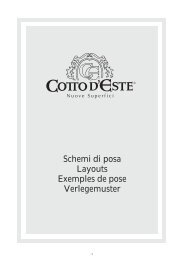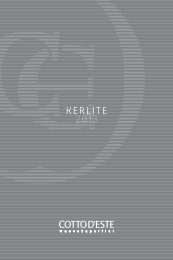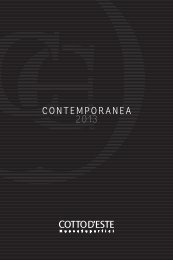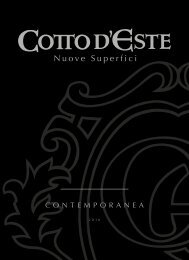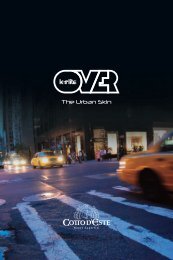catalogo classica - Cotto d'Este
catalogo classica - Cotto d'Este
catalogo classica - Cotto d'Este
You also want an ePaper? Increase the reach of your titles
YUMPU automatically turns print PDFs into web optimized ePapers that Google loves.
CARATTERISTICHE TECNICHE - TECHNICAL CHARACTERISTICS - CARACTÉRISTIQUES TECHNIQUES - TECHNISCHE EIGENSCHAFTEN<br />
Resistenza allo scivolamento Slip resistance Résistance au glissement Rutschfestigkeit<br />
BCRA TORTUS BCRA TORTUS BCRA TORTUS BCRA TORTUS<br />
Metodo inglese per la determinazione<br />
���������������������������������<br />
���������������������������������<br />
opposta al trascinamento di una<br />
apparecchiatura (tortus) che viene<br />
����������������������������������������<br />
Il metodo si basa, mediante un<br />
dispositivo mobile, di determinare il<br />
coefficiente di attrito che materiali<br />
standardizzati, quali gomma e cuoio,<br />
hanno in condizioni di asciutto<br />
o bagnato una volta a contatto<br />
con una determinata superficie da<br />
pavimentazione.<br />
Come già indicato sopra il “tortus<br />
test” il metodo di riferimento<br />
per la legislazione nazionale di<br />
cui al paragrafo 8.2.2 del D.M.<br />
236/89 che nelle condizioni di<br />
Gomma asciutta e Cuoio bagnato<br />
prevede un coefficiente > 0,40.<br />
La macchina di prova per la<br />
rilevazione del coefficiente di<br />
attrito su superfici bagnate è il<br />
sistema Digital Sliptester Floor<br />
Slide Control FSC 2000, sistema<br />
computerizzato.<br />
��������� Scivolosità pericolosa<br />
������������� Scivolosità eccessiva<br />
������������� Attrito soddisfacente<br />
�������� Attrito eccellente<br />
Resistenza alle macchie Stain resistance Résistance aux taches Fleckenbeständigkeit<br />
ISO 10545-14 ISO 10545-14 ISO 10545-14 ISO 10545-14<br />
La superficie d’esercizio viene<br />
posta a contatto con tre agenti<br />
macchianti, olio d’oliva,<br />
soluzione alcolica di iodio e<br />
verde cromo in olio leggero; dopo<br />
24 ore si procede alla pulizia<br />
Classe 5 - macchia rimossa con<br />
acqua calda corrente per 5 minuti<br />
Classe 4 - macchia rimossa<br />
mediante pulizia manuale con<br />
detergente debole<br />
Classe 3 - macchia rimossa<br />
mediante pulizia meccanica con<br />
detergente forte<br />
Classe 2 - macchia rimossa<br />
mediante immersione in idoneo<br />
solvente per 24 ore<br />
English method for determining<br />
the coefficient of friction of<br />
surfaces based on the resistance<br />
opposed to the movement of a<br />
tester instrument (Tortus) that<br />
traverses the surface to be tested.<br />
The method is based on the use<br />
of a mobile device to determine<br />
the coefficient of friction that<br />
standard materials, such as<br />
rubber and leather, have in<br />
wet or dry conditions further<br />
to contact with a certain floor<br />
covering material.<br />
As explained above, the “Tortus<br />
test” is the reference method<br />
for National legislation under<br />
paragraph 8.2.2 of Ministerial<br />
Decree 236/89, which envisages<br />
a coefficient equal to >0.40<br />
in dry Dry Rubber and Wet<br />
Leather conditions. The friction<br />
coefficient testing machine<br />
for wet surfaces is the Digital<br />
Sliptester Floor Slide Control FSC<br />
2000 system, which is computercontrolled.<br />
��������� Dangerous sliding<br />
������������� Excessive sliding<br />
������������� Satisfaction friction<br />
�������� Excellent friction<br />
The operating surface is subject<br />
to three staining agents, olive<br />
oil, iodine alcohol solution and<br />
chromium green in light oil;<br />
after 24 hours the surface is<br />
cleaned.<br />
Class 5 - stain removed with<br />
warm water running for 5 minutes<br />
Class 4 - stain removed by<br />
manual cleaning with mild<br />
detergent<br />
Class 3 - stain removed by<br />
mechanical cleaning with<br />
strong detergent<br />
Class 2 - stain removed by<br />
dipping in suitable thinner for<br />
24 hours<br />
81<br />
Méthode anglaise pour la<br />
détermination du coefficient de<br />
frottement des surfaces en fonction<br />
de la résistance opposée au<br />
glissement d’un appareil (Tortus)<br />
sur la surface elle-même.<br />
Cette méthode consiste, par le<br />
biais d’un dispositif mobile,<br />
à déterminer le coefficient de<br />
frottement que des matières<br />
standardisées, telles que le<br />
caoutchouc et le cuir, possèdent<br />
sur des surfaces sèches ou<br />
mouillées en contact avec un sol<br />
bien précis.<br />
Ledit « Tortus Test », méthode<br />
de référence pour la législation<br />
nationale visée au paragraphe<br />
8.2.2 du D.M. 236/89, prévoit<br />
dans des conditions de<br />
Caoutchouc sec et Cuir mouillé un<br />
coefficient > 0,40. Le mesurage<br />
du coefficient de frottement sur<br />
des surfaces mouillées est obtenu<br />
au moyen du système informatisé<br />
Digital Sliptester Floor Slide<br />
Control FSC 2000.<br />
��������� Glissance dangereuse<br />
������������� Glissance excessive<br />
������������� Frottement satisfaisant<br />
�������� Frottement excellent<br />
La surface de travail est mise au<br />
contact de trois agents tachants,<br />
huile d’olive, solution alcoolique à<br />
base d’iode et de chrome vert dans<br />
une huile légère ; le nettoyage est<br />
effectué après 24 heures.<br />
Classe 5 - tache enlevée à l’eau<br />
chaude courante (5 minutes)<br />
Classe 4 - tache enlevée par<br />
nettoyage manuel avec un produit<br />
léger<br />
Classe 3 - tache enlevée par<br />
nettoyage mécanique avec un<br />
produit fort<br />
Classe 2 - tache enlevée par<br />
immersion dans un solvant<br />
approprié pendant 24 heures<br />
Englische Methode zur Bestimmung<br />
des Reibungskoeffizienten<br />
der Oberflächen aufgrund des<br />
Widerstandes, der der Schleppkraft<br />
einer Apparatur (Tortus) geleistet<br />
wird, die die Oberfläche selbst<br />
durchquert.<br />
Die Methode basiert darauf, mit<br />
Hilfe einer beweglichen Vorrichtung,<br />
den Reibungskoeffizienten zu<br />
ermitteln, den Standardmaterialen<br />
wie Gummi und Leder in trockenem<br />
und nassem Zustand in Kontakt mit<br />
einer bestimmten Fußbodenfläche<br />
aufweisen.<br />
Wie bereits oben erwähnt, ist die<br />
Tortus-Testmethode die Grundlage<br />
für die nationale Gesetzgebung,<br />
siehe Paragraph 8.2.2 des<br />
Ministerialerlasses 236/89, die für<br />
trockenes Gummi und nasses Leder<br />
einen Koeffizienten > 0,40 vorsieht.<br />
Die Testmaschine zur Ermittlung des<br />
Reibungskoeffizienten auf nassen<br />
Oberflächen ist das EDV-System<br />
Digital Sliptester Floor Slide Control<br />
FSC 2000.<br />
��������� Gefährliche Rutschigkeit<br />
������������� Übermäßige Rutschigkeit<br />
������������� Mittelmäßige Reibung<br />
�������� Ausgezeichnete Reibung<br />
Auf die Betriebsoberfläche werden<br />
drei fleckenbildende Agens,<br />
Olivenöl, eine alkoholische Jod-<br />
Lösung und Grünchrom in Leichtöl<br />
gegeben. Nach 24 Stunden erfolgt<br />
die Reinigung.<br />
Klasse 5 - Der Fleck verschwindet<br />
nach einer 5-minütigen Behandlung<br />
mit warmem Wasser.<br />
Klasse 4 - Der Fleck verschwindet<br />
nach einer Behandlung von Hand<br />
mit einem leichten Reinigungsmittel.<br />
Klasse 3 - Der Fleck verschwindet<br />
nach einer mechanischen Behandlung<br />
mit einem starken Reinigungsmittel.<br />
Klasse 2 - Der Fleck verschwindet,<br />
nachdem die Oberfläche 24 Stunden<br />
lang in einem entsprechenden<br />
Lösungsmittel eingelegt wurde.<br />
Classe 1 - macchia non rimossa Class 1 - stain not removed Classe 1 - tache tenace Klasse 1 - Der Fleck bleibt.<br />
Visibilità delle impronte Tread mark visibility Visibilité des empreintes Sichtbarkeit von Fußspuren<br />
Metodo <strong>Cotto</strong> d’Este <strong>Cotto</strong> d’Este Method Méthode <strong>Cotto</strong> d’Este <strong>Cotto</strong> d’Este Verfahren<br />
����������������������������������������<br />
di visibilità delle impronte rilasciate sul<br />
pavimento dopo il passaggio con scarpe<br />
sporche di polvere.<br />
This classification specifies the<br />
visibility degree of the tread<br />
marks left on the floor after<br />
walking with shoes dirty of dust.<br />
Cette classification indique le degré<br />
de visibilité des empreintes laissées<br />
sur le sol après le passage avec des<br />
chaussures couvertes de poussière.<br />
Diese Klassifikation bezeichnet<br />
den Grad der Sichtbarkeit von<br />
Fußspuren, wenn der Boden mit<br />
staubigen Schuhen überquert wird.<br />
A - Impronta non visibile A - Tread mark not visible A - Empreinte non visible A - Keine Spuren sichtbar.<br />
B - Impronta poco visibile B - Tread mark not very visible B - Empreinte peu visible B - Schwach sichtbare Spuren.<br />
C - Impronta molto visibile.<br />
Consigliato solo in ambienti<br />
residenziali.<br />
C - Tread mark very visible.<br />
Recommended for residential<br />
environments only.<br />
C - Empreinte fort visible.<br />
Conseillé en milieu résidentiel<br />
uniquement.<br />
C - Gut sichtbare Spuren.<br />
Empfehlenswert nur in<br />
Wohnbereichen.




